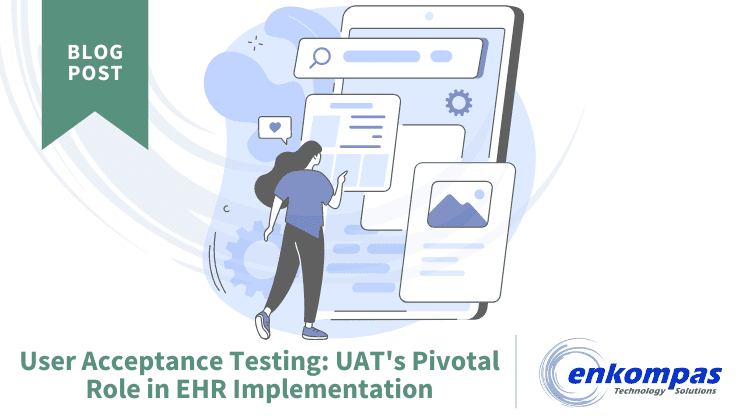Implementing an Electronic Health Record (EHR) involves many important elements, such as planning, designing workflows, data migration, and more. One critical phase of an EHR implementation that’s often overlooked is User Acceptance Testing (UAT). Serving as one of the final checkpoints before a new EHR system goes live, UAT allows end-users to validate that the system meets their needs and functions as intended in real-world scenarios. Like “measure twice; cut once,” UAT helps to ensure your organization gets it right the first time.
The Pivotal Role of User Acceptance Testing in EHR Implementation
During UAT, clinicians, nurses, and administrative staff interact with the EHR in a controlled environment, simulating day-to-day operations to ensure the system can handle routine tasks, complex workflows, and potential edge cases. This hands-on evaluation not only helps identify and resolve issues that may have been missed during earlier testing phases but also plays a crucial role in gaining user buy-in and facilitating a smooth transition to the new system.
Let’s take a close look at the ways UAT is pivotal for any EHR implementation.

Experience Growth in Your Company Through EHR Optimization
UAT Ensures System Alignment with User Needs
UAT serves as the final litmus test to ensure that the developed EHR system aligns with the needs and expectations of its end-users, such as healthcare providers, administrators, and support staff. By engaging end-users in the testing process, organizations can identify any discrepancies between system functionality and user requirements, facilitating necessary adjustments before widespread implementation.
UAT Validates System Functionality
User Acceptance Testing provides a real-world environment for testing the functionality, usability, and performance of the EHR system. It allows end-users to interact with the system in simulated operational scenarios, uncovering any bugs, glitches, or usability issues that may impede workflow efficiency or compromise patient care.
User Acceptance Testing Enhances User Adoption and Buy-In
Involving end-users in the UAT process fosters a sense of ownership and investment in the EHR system. By soliciting feedback and addressing user concerns during testing, organizations demonstrate a commitment to meeting user needs and enhancing their overall experience. This proactive approach not only increases user satisfaction but also cultivates user buy-in and acceptance of the new system.
In this sense, UAT can be considered as part of an effective Organizational Change Management strategy – one that mitigates resistance to change during implementation.
UAT Mitigates Risks and Cost Overruns
UAT serves as a quality assurance mechanism, helping organizations identify and rectify issues early in the implementation lifecycle. By detecting and addressing potential problems before full deployment, organizations can mitigate the risk of costly rework, system failures, or disruptions to clinical operations post-implementation.
EHR Specialists Help with User Acceptance Testing
Given the critical role of UAT in ensuring the success of EHR implementations, it needs to be done thoroughly and effectively. Engaging a consultant who specializes in EHR implementation and optimization can offer several advantages.
Expertise and Best Practices
Consultants bring specialized knowledge, expertise, and best practices gleaned from prior EHR implementations across various healthcare settings. Their insights can help organizations streamline the UAT process, optimize testing strategies, and anticipate potential challenges, thereby enhancing the effectiveness and efficiency of testing efforts.
Objective Perspective
Consultants provide an impartial and objective perspective during the User Acceptance Testing process, free from internal biases or preconceptions. They can offer fresh insights, identify blind spots, and challenge existing assumptions, fostering a more rigorous and comprehensive evaluation of the EHR system from end-user perspectives.
Resource Augmentation
Consultants can supplement internal resources and capabilities, particularly in organizations with limited testing expertise or capacity. Whether it’s developing test cases, executing test scripts, or analyzing test results, consultants can augment the testing team, ensuring thorough coverage and timely completion of testing activities.
Risk Management and Compliance
Consultants can help organizations navigate regulatory requirements, industry standards, and compliance mandates governing EHR implementations. By aligning UAT activities with regulatory guidelines and quality standards, consultants assist organizations in mitigating compliance risks and ensuring the integrity and security of patient health information.
User Acceptance Testing Requires Collaboration
Ultimately, while consultants can provide valuable support and expertise, it’s essential for organizations to recognize that UAT is not solely the responsibility of external parties. Rather, it requires active participation and collaboration between the implementing agency, end-users, and stakeholders throughout the testing process. By taking ownership of UAT and prioritizing user feedback and engagement, organizations can optimize the success of their EHR initiatives and deliver tangible benefits to both healthcare providers and patients alike.
About enkompas Technology Solutions
enkompas powers your entire technology environment, working closely with your team to provide strategic enterprise technology solutions. With nearly 30 years of experience as a trusted managed IT services partner, our goal is to help you build a secure, scalable organizational roadmap. Contact us for more information on how enkompas Technology Solutions can help your organization select an EHR, achieve EHR implementation success, and support your secure tech environment with our subject matter expertise and proven Organizational Change Management Blueprint.


